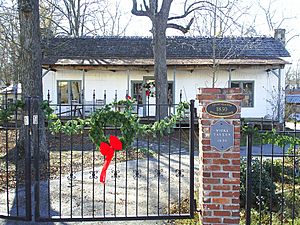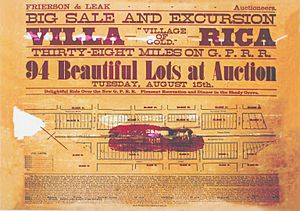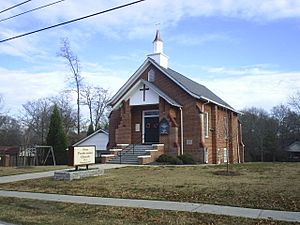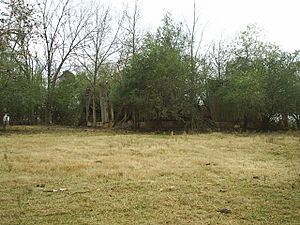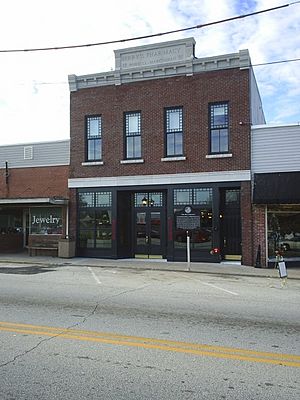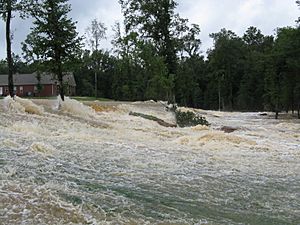Villa Rica, Georgia facts for kids
Quick facts for kids
Villa Rica, Georgia
|
|||
|---|---|---|---|
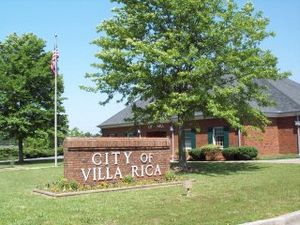
City Hall on Bankhead Highway
|
|||
|
|||
| Nickname(s):
The City of Gold
|
|||
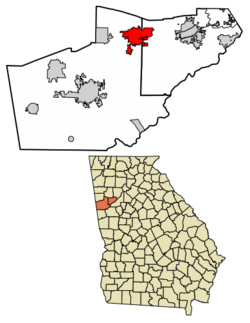
|
|||
| Country | United States | ||
| State | Georgia | ||
| Counties | Carroll, Douglas | ||
| Hixtown | 1826 | ||
| Villa Rica | 1881 | ||
| Named for | Historic Gold Rush and Mines | ||
| Government | |||
| • Type | Council Manager | ||
| Area | |||
| • Total | 14.78 sq mi (38.28 km2) | ||
| • Land | 14.65 sq mi (37.93 km2) | ||
| • Water | 0.13 sq mi (0.34 km2) | ||
| Elevation | 1,138 ft (347 m) | ||
| Population
(2021)
|
|||
| • Total | 17,830 | ||
| • Density | 1,158.68/sq mi (447.36/km2) | ||
| Time zone | UTC-5 (EST) | ||
| • Summer (DST) | UTC-4 (EDT) | ||
| ZIP code |
30180
|
||
| Area code(s) | 404/678/470/770 | ||
| FIPS code | 13-79528 | ||
| GNIS feature ID | 0333333 | ||
Villa Rica /ˌvɪlə ˈrɪkə/ means "Rich Village" in Spanish, Italian, and Portuguese. It is a city located in Carroll and Douglas counties in the U.S. state of Georgia. Villa Rica is part of the larger Atlanta metropolitan area.
Some areas in Paulding County also use Villa Rica postal addresses, even though they are not officially part of the city.
Contents
History of Villa Rica
The area that became Villa Rica was first settled in 1826. It was located along what is now Dallas Highway. This land was given up by the Creek people in 1825. This happened with the second Treaty of Indian Springs, signed by Chief William McIntosh.
In 1826, farmers and gold miners came to the area. They were from Pennsylvania, New Jersey, and Delaware. This settlement was first called "Hixtown," named after a local tavern owner. It became an official town in 1830. About a mile south was Chevestown, owned by Allison Cheeves.
Both Hixtown and Cheevestown moved to Villa Rica's current spot in 1882. This move happened when the railroad was built. Many original buildings were moved by rolling them on logs with horses. This new area is now known as the North Villa Rica Commercial Historic District. The city officially became Villa Rica in 1881. The name "Villa Rica" was chosen to highlight the gold found in the area.
Early Gold Mining in Hixtown
Soon after settlers arrived in 1826, gold was found. Carroll County was also created in 1826. It was named after Charles Carroll of Carrollton, who signed the Declaration of Independence.
While not as big as the later Georgia Gold Rush, a small gold rush happened in Villa Rica in the late 1820s. When the main Georgia Gold Rush began in 1829, many Villa Rica miners moved to the Dahlonega area. Still, some mining continued in Villa Rica. Hundreds of men worked in nearby mines. By 1832, Hixtown had over 2,000 residents. Gold lots were very expensive, costing $500 per acre. There were at least 19 active gold mines. By 1860, most of the gold in the area was gone.
Early Villa Rica had a rough, frontier feel. The area was originally part of the Creek Nation. However, the Creek people moved from their lands after the Treaty of Washington in 1826. By 1827, there were no more Creek people in Georgia. Most moved west to Alabama.
Growth of New Villa Rica
With the new railroad line, Hixtown and Cheevestown joined to form the new city of Villa Rica. The first train arrived in June 1882. A round-trip ticket from Atlanta cost only $1.00.
The young community faced two big fires. The first fire in 1890 destroyed a whole block of wooden stores on Montgomery Street. The second fire happened on July 27, 1908. It started in a drug store and spread quickly. A quarter of Villa Rica's business area was destroyed in three hours. In 1957, a gas leak caused an explosion. It destroyed four buildings and killed 12 people.
The Bankhead Highway was planned and built through Villa Rica in 1917. It was named after Senator John H. Bankhead. This was the second highway to cross the United States and the first that could be used in all weather. In the 1930s, it was moved through town, which changed Montgomery Street. It was a main road until Interstate 20 opened in December 1977.
On May 14, 1961, Freedom Riders traveled through Villa Rica.
Historic Places to Visit
- Wicks Tavern (built around 1830) is the oldest business building in Carroll County. John B. Wick, an immigrant from New York, built it in Hixtown. It was a popular meeting spot for gold miners. The building shows a special "Dutch"-style timber framing. When the railroad came in 1882, the tavern was too big to move. It became a home. In 1998, a group called "Friends of Wick's Tavern" saved it from being torn down. They moved it to downtown Villa Rica. Today, Wicks Tavern is a living history museum.
- The Stockmar Gold Mine (from the 19th and 20th centuries) is now a city park and gold museum. It is called the Pine Mountain Gold Museum at Stockmar Park. It opened in 2008 and is an important historical site for the city.
- Fullerville (1916–1956) is a small area northwest of Villa Rica. It used to have several textile mills. Fullerville became an official town in 1916 but joined Villa Rica in 1956. The area still looks like it did in the early 1900s. Its most famous building is the Fullerville Jail, which dates back to 1828.
- Mt. Prospect Baptist Church started in July 1887. The first church building was built between 1888 and 1890. This is where Thomas A. Dorsey learned about music. The second church building, built in 1928, was the first church owned by Black people in Carroll County. This building burned down in 1945. A new church was built quickly in five months. In 2005, work began on a larger church next to it. The congregation moved into the new church on March 11, 2007.
- The First Presbyterian Church of Villa Rica began in 1855. A white wooden building was built in 1885. In 1930, the building was moved to its current spot. It was covered in brick, and a basement was added for Sunday School. The church bought its mahogany pews, pulpit, and stained glass windows from an old church in Atlanta. These windows are very old and special.
- First United Methodist Church of Villa Rica: It is believed that the Methodist Church built its first building, a log cabin, in 1830. This would make it the first church in the city. Around 1845, a wooden church was built. When Hixtown moved and Villa Rica was created, the church decided to build a new white wooden church. It was built in 1886 at the current church site. The old church was left in 1890. Construction on the current church began in 1905 and was first used in July 1906.
National Historic Places
The Dorough Round Barn and Farm was added to the National Register of Historic Places in 1980. It is about 3 miles southwest of Villa Rica. The farm has a 19th-century farmhouse, other buildings, and the famous round barn. Built in 1917, the Round Barn is special because of its circular shape. This was a modern farming method at the time. The barn was designed by Floyd Lovell. It had two levels. The top level is now gone, and the bottom level is also falling apart. The barn is privately owned.
The North Villa Rica Commercial Historic District was added to the National Register of Historic Places in 2002. This area includes several blocks of buildings, some from 1875. They were built in an early business style. The area has the Villa Rica Police Department, antique stores, restaurants, and other businesses.
The Williams Family Farm was added to the National Register of Historic Places in 2005. The farmhouse, built in 1892, is in great shape. It sits in front of a Civilian Conservation Corps camp from 1937. This camp helped farmers with their cotton fields. The farm also has other old buildings and a historic landscape. It is also known as the Williams-Mitchell Farm.
The Pine Mountain Gold Museum at Stockmar Park was added to the National Register of Historic Places in 2008. The city's 1826 gold rush happened at Stockmar Park. A museum was built to share its story. You can see remains of original buildings and equipment there. There is also a gold panning area and farm animals.
Historical Markers
Villa Rica has four historical markers.
- The first marker was put up in 1994. It marks the birthplace of Thomas A. Dorsey, known as the "father of gospel songs." Dorsey learned music at Mt. Prospect Baptist Church. He became a famous blues musician called Georgia Tom. After his family died, he returned to religious music. His blues background helped create a new style called gospel music.
- The second marker was put up in 2003. It shares information about the Tyson family's old home, "the grove." The Tysons moved here in 1853 and are one of Villa Rica's oldest families.
- The third marker was put up in 2007 for the 50th anniversary of the Villa Rica Explosion. A gas leak at Berry's Pharmacy caused the explosion. It destroyed that building and three others nearby. Twelve people died, and twenty were hurt. This was the worst event in Carroll County history for injuries and deaths.
- The fourth marker was put up in 2011 by the Villa Rica Historic Preservation Commission. It notes that Freedom Riders passed through Villa Rica on May 14, 1961, without major problems.
September 2009 Flooding
On September 21, 2009, a huge flood hit Georgia, including Villa Rica. It caused about $500 million in damage across the state. In Villa Rica, water lines and other important systems were damaged. Many residents were without water for almost a week.
Geography and Climate
Villa Rica is in northeastern Carroll County, northwestern Douglas County, and parts of Paulding County. U.S. Route 78 (also called Bankhead Highway) goes through the city center. It leads west to Temple and east to Douglasville. Interstate 20 runs through the southern part of the city. It connects Villa Rica to Atlanta in the east and Oxford, Alabama in the west.
The city covers about 14.78 square miles (38.28 square kilometers). Most of this is land, with a small amount of water. Villa Rica is on a ridge that separates the Chattahoochee and Tallapoosa river basins. Just over half of Villa Rica is in Carroll County, and the rest is in Douglas County.
Weather in Villa Rica
Villa Rica has a humid subtropical climate. This means it has hot, humid summers and mild to chilly winters. July is usually the warmest month. The highest temperature ever recorded was 103°F (39°C) in 1980. January is usually the coolest month. The lowest temperature ever recorded was -9°F (-23°C) in 1985. March usually gets the most rain.
Even though Villa Rica is far from the Gulf of Mexico and the Atlantic Ocean, it can sometimes be affected by hurricanes. Tornadoes are more common in the area, but they are usually not as strong as those in the central United States.
| Climate data for Villa Rica, Georgia | |||||||||||||
|---|---|---|---|---|---|---|---|---|---|---|---|---|---|
| Month | Jan | Feb | Mar | Apr | May | Jun | Jul | Aug | Sep | Oct | Nov | Dec | Year |
| Record high °F (°C) | 81 (27) |
80 (27) |
93 (34) |
92 (33) |
96 (36) |
100 (38) |
103 (39) |
102 (39) |
100 (38) |
97 (36) |
86 (30) |
81 (27) |
103 (39) |
| Mean daily maximum °F (°C) | 52 (11) |
57 (14) |
65 (18) |
72 (22) |
79 (26) |
85 (29) |
88 (31) |
87 (31) |
82 (28) |
73 (23) |
64 (18) |
55 (13) |
72 (22) |
| Mean daily minimum °F (°C) | 29 (−2) |
31 (−1) |
38 (3) |
44 (7) |
53 (12) |
61 (16) |
66 (19) |
65 (18) |
59 (15) |
46 (8) |
38 (3) |
31 (−1) |
47 (8) |
| Record low °F (°C) | −9 (−23) |
3 (−16) |
9 (−13) |
24 (−4) |
30 (−1) |
36 (2) |
47 (8) |
48 (9) |
32 (0) |
23 (−5) |
2 (−17) |
0 (−18) |
−9 (−23) |
| Average rainfall inches (mm) | 5.53 (140) |
5.07 (129) |
6.22 (158) |
4.38 (111) |
4.16 (106) |
3.86 (98) |
4.53 (115) |
3.70 (94) |
3.21 (82) |
3.36 (85) |
4.55 (116) |
4.44 (113) |
53.01 (1,347) |
| Source: The Weather Channel | |||||||||||||
Population Information
| Historical population | |||
|---|---|---|---|
| Census | Pop. | %± | |
| 1880 | 212 | — | |
| 1890 | 426 | 100.9% | |
| 1900 | 576 | 35.2% | |
| 1910 | 855 | 48.4% | |
| 1920 | 1,047 | 22.5% | |
| 1930 | 1,304 | 24.5% | |
| 1940 | 1,522 | 16.7% | |
| 1950 | 1,703 | 11.9% | |
| 1960 | 3,450 | 102.6% | |
| 1970 | 3,922 | 13.7% | |
| 1980 | 3,420 | −12.8% | |
| 1990 | 6,542 | 91.3% | |
| 2000 | 4,134 | −36.8% | |
| 2010 | 13,956 | 237.6% | |
| 2020 | 16,970 | 21.6% | |
| U.S. Decennial Census 1850-1870 1870-1880 1890-1910 1920-1930 1940 1950 1960 1970 1980 1990 2000 2010 2020 |
|||
In 2020, Villa Rica had 16,970 people living there. This was an increase from 13,956 people in 2010 and 4,134 people in 2000.
As of 2020, 8,367 Villa Rica residents lived in Carroll County. Another 5,589 lived in Douglas County.
Fun Things to Do
Villa Rica hosts several events and has entertainment options:
- Thomas A. Dorsey Festival: Held near July 1st, this festival celebrates gospel music and blues.
- Gold Rush Festival: This event takes place the Saturday after Labor Day.
- Homecoming Parade/Pep Rally
- The movie Randy and the Mob was filmed mostly in Villa Rica in August 2005.
- Taste of VR
- Golden City Car Cruisers - Cruise In
- The MILL Amphitheater
- V-PLEX Fireworks Show
Education in Villa Rica
Schools in Carroll County are part of the Carroll County School District. Schools in Douglas County are part of the Douglas County School District.
Carroll County Schools
The Carroll County School District teaches students from pre-school through 12th grade. It has twelve elementary schools, six middle schools, and five high schools. In the 2019–20 school year, the district had over 15,000 students. Schools in Villa Rica that are part of this district include:
- Villa Rica High School
- Bay Springs Middle School
- Glanton-Hindsman Elementary School
- Ithica Elementary School
- Villa Rica Elementary School
Other Public Schools
The Douglas County School District runs Mirror Lake Elementary School, which is located in Villa Rica. New Georgia Elementary School is in Paulding County and is run by the Paulding County School District.
Private Schools
- Sunbrook Academy at Bay Springs
- Mirror Lake Academy
Transportation and Roads
Main Roads
Walking and Biking Paths
- Gold Nugget Trail (Planned)
Railroads
In the past, the Southern Railway ran several daily passenger trains through Villa Rica. These trains included the Kansas City-Florida Special, the Sunnyland, and a section of the Piedmont Limited. The last passenger trains stopped in Villa Rica in 1967.
Famous People from Villa Rica
- Asa Griggs Candler: A business leader who helped make Coca-Cola famous. He was also a mayor of Atlanta.
- Warren Akin Candler: A bishop in the Methodist Church and a former president of Emory University.
- James A. "J." Collins: A funeral director and politician. He was a mayor of Villa Rica and served in the Georgia House of Representatives.
- Jae Crowder: A professional basketball player for the Milwaukee Bucks.
- Thomas A. Dorsey: An important person in creating black gospel music.
- Maidie Norman: An actress.
- David M. Parsons: A poet laureate of Texas in 2011.
- Rufus B. Nalley: A pioneering college football player in the U.S.
- Rod Man: A standup comedian who won Last Comic Standing.
- Morgan Saylor: An actress.
- Dixie Walker: A professional baseball player.
- Herman "Thunderfoot" Weaver: A professional football player.
Images for kids
See also
 In Spanish: Villa Rica (Georgia) para niños
In Spanish: Villa Rica (Georgia) para niños




